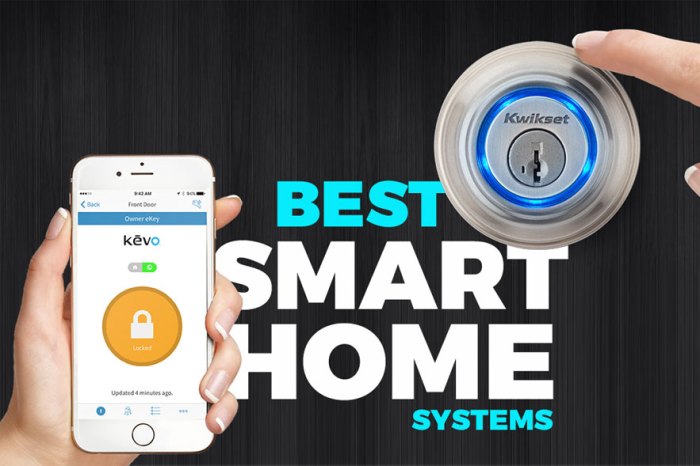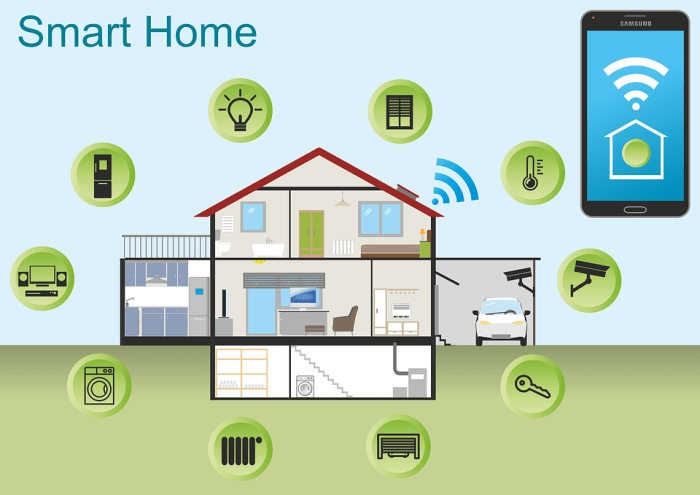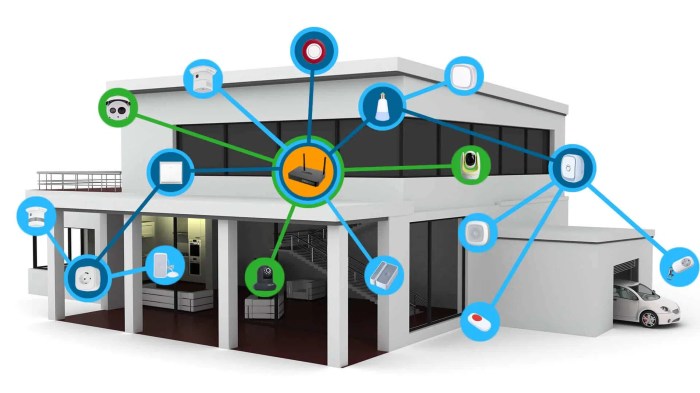In the realm of modern living, smart home systems have emerged as transformative forces, redefining the way we interact with our living spaces. These ingenious systems seamlessly integrate technology and automation, offering an array of benefits that enhance convenience, security, energy efficiency, and comfort.
From lighting control and climate management to entertainment and security, smart home systems orchestrate a symphony of connected devices, empowering homeowners with unprecedented control and personalization. As we delve into the intricacies of smart home systems, we’ll explore their components, advantages, and various types, guiding you towards an informed decision when choosing the perfect system for your unique needs.
Introduction to Smart Home Systems
Smart home systems are revolutionizing the way we live, transforming our homes into intelligent and interconnected spaces. They integrate various technologies and devices to provide convenience, energy efficiency, security, and automation. Embracing the concept of the Internet of Things (IoT), these systems allow homeowners to control and monitor their homes from anywhere, using smartphones, tablets, or voice assistants.
Smart home systems encompass a range of components and technologies, including smart thermostats, lighting systems, security cameras, door locks, and appliances. These devices communicate with each other through a central hub or platform, enabling homeowners to create customized routines and automations based on their preferences and needs.
Smart home systems not only enhance comfort and convenience but also offer significant benefits in terms of energy savings, security, and remote access.
Components of Smart Home Systems
Smart home systems typically consist of the following components:
- Central Hub or Platform: The central hub or platform serves as the brain of the smart home system, connecting and coordinating all devices and components. It allows homeowners to control and monitor their smart home devices from a single interface.
- Smart Devices: Smart devices are devices equipped with sensors, actuators, and connectivity capabilities, enabling them to communicate with the central hub and respond to commands. Examples include smart thermostats, lighting systems, door locks, and appliances.
- Connectivity: Smart home systems rely on various communication technologies, such as Wi-Fi, Bluetooth, and Zigbee, to connect devices and enable communication between them and the central hub.
- Mobile App or Web Interface: Homeowners can control and monitor their smart home systems using a mobile app or web interface, providing remote access and the ability to create automations and customized routines.
- Voice Assistants: Smart home systems often integrate with voice assistants like Amazon Alexa, Google Assistant, or Apple Siri, allowing homeowners to control their smart devices using voice commands.
Benefits of Smart Home Systems
Smart home systems offer a multitude of advantages that enhance convenience, energy efficiency, security, and comfort within the household. These systems integrate various technologies to automate and control home appliances, devices, and features, creating a more connected and responsive living environment.
One of the primary benefits of smart home systems is the enhanced convenience they provide. With voice commands or mobile applications, homeowners can effortlessly control lighting, thermostats, door locks, and entertainment systems. This eliminates the need for manual adjustments, saving time and effort while promoting a more streamlined and comfortable living experience.
Energy Efficiency
Smart home systems contribute significantly to energy efficiency and sustainability. Automated thermostats can adjust heating and cooling based on occupancy and preferences, preventing energy wastage. Smart lighting systems can detect ambient light levels and adjust brightness accordingly, reducing energy consumption.
Furthermore, smart appliances can be programmed to operate during off-peak hours, taking advantage of lower electricity rates and minimizing energy costs.
Security and Safety
Smart home systems provide enhanced security and safety features. Motion sensors and surveillance cameras can monitor the home’s surroundings, sending real-time alerts to homeowners’ smartphones in case of suspicious activity. Smart locks can be controlled remotely, allowing homeowners to grant or deny access to visitors, even when they are away from home.
Additionally, smart smoke and carbon monoxide detectors can promptly notify homeowners of potential hazards, enabling timely intervention and ensuring the safety of occupants.
Enhanced Comfort
Smart home systems contribute to a more comfortable and enjoyable living environment. Automated climate control systems maintain consistent temperatures throughout the home, ensuring optimal comfort levels. Smart lighting systems can be programmed to adjust brightness and color temperature based on the time of day or activity, creating the desired ambiance for various occasions.
Smart entertainment systems can be seamlessly integrated, allowing homeowners to enjoy their favorite music, movies, and shows with ease.
Eco-friendly Lifestyle
Smart home systems can facilitate a more sustainable and eco-friendly lifestyle. By optimizing energy usage, reducing carbon emissions, and promoting responsible resource management, smart homes contribute to a greener and more sustainable future. Additionally, smart home systems can be integrated with renewable energy sources such as solar panels and wind turbines, allowing homeowners to generate their own clean energy and further reduce their environmental impact.
Types of Smart Home Systems
Smart home systems are broadly categorized based on their functionality, each type offering unique benefits and applications. These categories include lighting control, climate control, security systems, and entertainment systems.
Lighting Control Systems
Smart lighting systems allow homeowners to remotely control and automate their home’s lighting fixtures. Key features include scheduling, dimming, and color customization. These systems enhance convenience, energy efficiency, and security.
Climate Control Systems
Smart climate control systems regulate temperature, humidity, and air quality. They enable remote adjustment of thermostats, fans, and air conditioners. These systems improve comfort, energy efficiency, and air quality.
Security Systems
Smart security systems protect homes from unauthorized access and potential threats. Features include motion sensors, door and window sensors, and surveillance cameras. These systems offer peace of mind, deter crime, and enable remote monitoring.
Entertainment Systems
Smart entertainment systems integrate audio and visual components to provide a seamless entertainment experience. Features include multi-room audio, home theater systems, and streaming services. These systems enhance entertainment and provide a personalized experience.
Factors to Consider When Choosing a Smart Home System

Selecting a smart home system requires careful consideration of various factors to ensure compatibility, ease of use, scalability, and long-term support. These factors help you make an informed decision that aligns with your specific needs, preferences, and budget constraints.
Compatibility with Existing Devices
Assessing the compatibility of the smart home system with your existing devices is crucial. Consider the following aspects:
- Device Types: Determine if the system supports the types of devices you already own or plan to purchase, such as smart lights, thermostats, door locks, and security cameras.
- Connectivity Protocols: Ensure that the system uses connectivity protocols compatible with your devices. Common protocols include Wi-Fi, Bluetooth, Zigbee, and Z-Wave.
- Device Brands: Some systems may only work with devices from specific brands. Check if the system supports the brands you prefer or are willing to purchase.
Popular Smart Home System Brands

Smart home systems are becoming increasingly popular, and several brands offer a variety of options to suit different needs and budgets. This section compares four leading brands: Nest, Amazon Echo, Google Home, and Apple HomeKit.
Features
Nest offers a wide range of smart home products, including thermostats, smoke detectors, and security cameras. Amazon Echo devices are known for their voice control capabilities and integration with Amazon’s Alexa virtual assistant. Google Home devices offer similar features to Amazon Echo, but they are powered by Google Assistant.
Apple HomeKit is a platform that allows users to control various smart home devices from their Apple devices.
Compatibility
Nest products are generally compatible with other Nest products, as well as with a limited number of third-party devices. Amazon Echo devices are compatible with a wide range of smart home devices from various brands. Google Home devices are also compatible with a wide range of smart home devices, but they may not be compatible with as many devices as Amazon Echo devices.
Apple HomeKit is only compatible with Apple devices and a limited number of third-party devices.
Pricing
Nest products are generally more expensive than Amazon Echo and Google Home devices. Amazon Echo devices are typically the most affordable option, followed by Google Home devices and then Nest products. Apple HomeKit devices vary in price depending on the specific device and brand.
Customer Reviews
Nest products generally receive positive customer reviews, with users praising their ease of use, reliability, and sleek design. Amazon Echo devices also receive positive customer reviews, with users appreciating their voice control capabilities and integration with Amazon’s Alexa virtual assistant.
Google Home devices also receive positive customer reviews, with users liking their voice control capabilities and compatibility with a wide range of smart home devices. Apple HomeKit devices receive mixed customer reviews, with some users praising their seamless integration with Apple devices and others criticizing their limited compatibility and high price.
Smart Home System Installation and Setup

Installing and setting up a smart home system can be a straightforward process with the right preparation and attention to detail. Follow these steps to ensure a smooth and successful installation:
1. Gather Information and Plan
- Research and select the smart home system that best suits your needs and budget.
- Determine the devices you want to integrate, such as lights, thermostats, door locks, and security cameras.
- Create a floor plan of your home, marking the locations where you want to place smart devices.
2. Purchase and Unpack Equipment
- Purchase the necessary smart home system components, including the hub, devices, and accessories.
- Unpack the equipment carefully and check for any damage or missing parts.
3. Install the Smart Home Hub
- Place the smart home hub in a central location with good Wi-Fi coverage.
- Connect the hub to your home’s Wi-Fi network according to the manufacturer’s instructions.
4. Connect Smart Devices
- Follow the instructions provided with each smart device to connect them to the hub.
- Use the smart home app to configure and personalize each device’s settings.
5. Set Up Routines and Schedules
- Create routines and schedules for your smart devices to automate tasks and optimize energy usage.
- For example, set lights to turn on at sunset and off at sunrise, or adjust the thermostat based on your daily schedule.
6. Troubleshooting Common Issues
- If you encounter any issues during installation or setup, refer to the manufacturer’s troubleshooting guide.
- Common issues include connectivity problems, device compatibility, and app configuration errors.
7. Test and Fine-Tune
- Once everything is set up, test the system thoroughly to ensure all devices are functioning properly.
- Make adjustments to routines and schedules as needed to optimize performance and meet your preferences.
8. Maintain and Update
- Keep your smart home system up-to-date with the latest firmware and software updates.
- Regularly check for new features and security patches to enhance the system’s functionality and security.
Security and Privacy Concerns in Smart Home Systems
As smart home systems become more prevalent, so do concerns about their security and privacy implications. These systems often collect and transmit sensitive data, making them potential targets for unauthorized access, data breaches, and hacking.
To enhance the security of smart home systems, users should implement strong passwords, enable two-factor authentication, and regularly update firmware and software. Additionally, choosing reputable brands and products that prioritize security can help mitigate potential risks.
Potential Security and Privacy Risks
- Unauthorized Access: Smart home systems can be vulnerable to unauthorized access, allowing intruders to gain control of devices, view camera feeds, or access personal information.
- Data Breaches: Collected data by smart home systems, such as usage patterns and personal preferences, can be intercepted or hacked, leading to data breaches and potential misuse.
- Hacking: Smart home systems can be hacked through vulnerabilities in software, firmware, or network connections, enabling attackers to remotely control devices or steal sensitive information.
Recommendations for Enhancing Security
- Strong Passwords: Use strong and unique passwords for all smart home devices and accounts, avoiding common or easily guessable combinations.
- Two-Factor Authentication: Enable two-factor authentication whenever available, adding an extra layer of security by requiring a second form of verification.
- Regular Updates: Regularly check for and install firmware and software updates, as they often include security patches and improvements.
- Reputable Brands: Choose smart home products and systems from reputable brands known for prioritizing security and privacy.
Integration and Compatibility with Other Devices

Integrating smart home systems with other devices like smartphones, tablets, and smart appliances is essential for seamless control and convenience. This connectivity allows users to interact with their smart home systems remotely, monitor device status, receive notifications, and make adjustments from anywhere.
Enhanced Functionality and Convenience
Integration with smartphones enables users to control their smart home systems using intuitive mobile apps. They can adjust lighting, thermostats, and security systems on the go. Integration with smart appliances allows users to automate tasks like cooking, cleaning, and laundry.
This seamless connectivity enhances the functionality and convenience of smart home systems, making them more user-friendly and efficient.
Future Trends in Smart Home Systems

Intro paragraphThe realm of smart home systems is constantly evolving, driven by technological advancements that promise to transform our living spaces into even more intelligent and responsive environments. From artificial intelligence (AI) and voice control to the pervasive connectivity of the Internet of Things (IoT), these emerging trends are poised to redefine the way we interact with our homes.
Artificial Intelligence (AI) and Machine Learning
[Detailed content here]AI and machine learning algorithms are revolutionizing smart home systems, enabling them to learn, adapt, and anticipate the needs of the occupants. These systems can analyze data from various sensors and devices to optimize energy usage, adjust lighting and temperature settings, and even suggest personalized recommendations for home automation.
Voice Control and Natural Language Processing
[Detailed content here]Voice control has become an integral part of smart home systems, allowing users to interact with their homes using natural language commands. This intuitive interface makes it easier for people of all ages and abilities to control smart devices, enhancing convenience and accessibility.
Internet of Things (IoT) and Connectivity
[Detailed content here]The Internet of Things (IoT) is expanding the reach of smart home systems by connecting various devices and appliances to the internet. This enables seamless communication and control of these devices from anywhere, providing homeowners with unprecedented levels of convenience and remote access.
Predictive Analytics and Personalized Automation
[Detailed content here]Smart home systems are becoming increasingly adept at predicting user preferences and patterns, enabling them to automate tasks and adjust settings based on these predictions. This level of personalization enhances the user experience and makes smart homes even more responsive and intuitive.
Integration and Interoperability
[Detailed content here]The future of smart home systems lies in their ability to seamlessly integrate with various devices and platforms. Open standards and protocols will facilitate interoperability, allowing devices from different manufacturers to communicate and work together harmoniously, creating a truly connected and intelligent home ecosystem.
Last Recap
As we stand at the threshold of a smarter future, smart home systems continue to evolve, promising an ever-expanding realm of possibilities. With advancements in artificial intelligence, voice control, and the Internet of Things, our homes are poised to become more intuitive, responsive, and energy-efficient than ever before.
Embracing smart home technology is not merely a choice but a step towards a future where our living spaces adapt to our needs, enhancing our comfort, security, and overall well-being.
Frequently Asked Questions
Question: What are the primary components of a smart home system? Answer: Smart home systems typically consist of sensors, actuators, controllers, and a user interface. Sensors gather data about the environment, actuators control devices, controllers process information and make decisions, and the user interface allows homeowners to interact with the system.
Question: How do smart home systems contribute to energy efficiency? Answer: By automating tasks like lighting, heating, and cooling, smart home systems can optimize energy usage, reducing energy waste and lowering utility bills. Additionally, they can track energy consumption patterns, providing valuable insights for further energy-saving measures.
Question: What are some popular smart home system brands? Answer: Some well-known smart home system brands include Nest, Amazon Echo, Google Home, and Apple HomeKit. Each brand offers unique features, compatibility, and pricing options, catering to diverse user needs and preferences.
Question: What security measures should be taken when using smart home systems? Answer: To ensure the security of smart home systems, it’s crucial to use strong passwords, regularly update software, and choose reputable brands and products.
Additionally, homeowners should be cautious about granting access to third-party apps and devices, and consider investing in additional security measures like firewalls and VPNs. Question: How can smart home systems be integrated with other devices? Answer: Smart home systems can be integrated with other devices through various methods, including Wi-Fi, Bluetooth, Zigbee, and Z-Wave.
This integration allows devices to communicate and work together seamlessly, creating a cohesive and responsive smart home ecosystem.